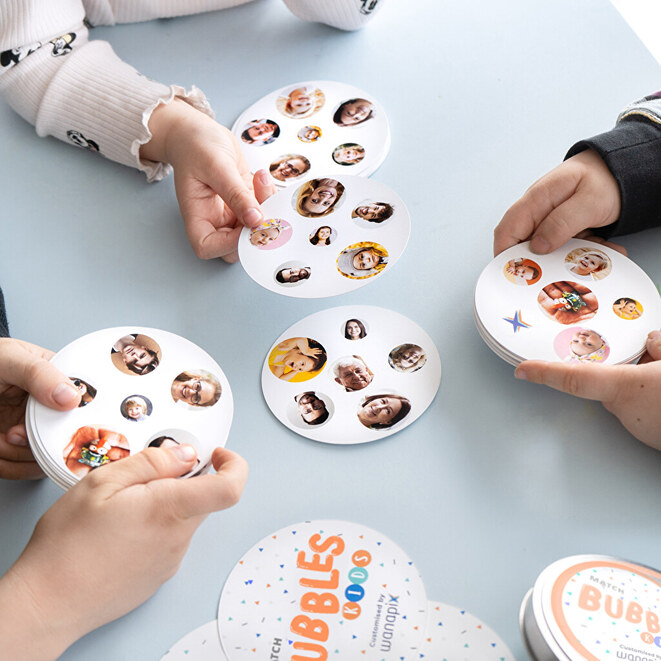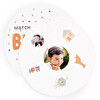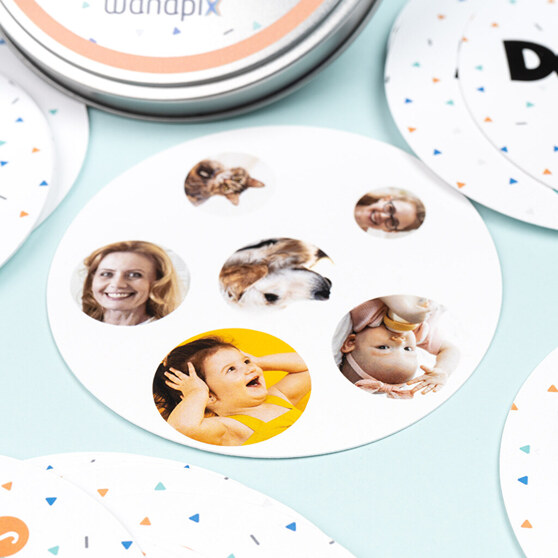






Personalised "Match Bubbles" card game
€15.95
Deliver on Tuesday, 16 December with fast shippingPlace your order before 13 hours 4 min.
In time for Christmas Day
In stock
Model

Match Bubbles Kids

Match Bubbles
Model
Basic
€15.95
Back + Box
€25.95
Details
- Measurements: 10ø cm (diameter)
- No minimum quantity, from 1 unit
- Only the symbols are personalised.
- Recommended minimum age: +5 years.
- Number of cards: 30 cards. Each card contains 6 symbols.
- There are 31 symbols in total. 30 can be personalised by the user.
- Family board game: 2 to 8 players.
- Game duration: 15 minutes (approx.).
- Card grammage: 350 gr.
- ID: #15780
- More details
designs
Reviews
4.46
378 opinions
5
- 67%
4
- 21%
3
- 5%
2
- 4%
1
- 3%

Description
Information
- Number of players: 2 to 8 players
- Duration of the game: 15 minutes (approx.)
- Minimum recommended age: +5 years
- Type: Card game
- Genre: family
Match Bubbles game with personalised symbols
The game Match Bubbles is a very popular card game all over the world, whose main features are mental and visual quickness, as well as speed and reflexes. The idea is very simple: all the cards in the deck have different symbols, and there is always one symbol, and only one, that matches between any two cards in the deck. During the game, two cards will be shown, and the goal is to be the first player to find the matching symbol.
The game is very fun, simple and family-friendly, for all ages. That alone makes it a perfect gift for anyone of any age. But what's more, this Match Bubbles game is customisable. That means that you can upload the symbols you want to appear on the cards from your mobile phone or computer. As in the basic game, there will always be only one matching symbol between any two cards. But the fact that these symbols can be the face of each member of the family, or the family dog or cat, or put friends, drawings or any logo or symbol you like, makes the game twice as original.
How to play Match Bubbles
Match Bubbles is a game that can be played in several different ways. In fact, we offer various game modes, so you could say that Match Bubbles is many games in one.
Before you start playing any game mode, shuffle your pack of cards well. These game modes are:
The Tower
Deal 1 face up to each player. Each player places his or her card on the table in front of him or her, face down (on the side without the symbols). The rest of the deck is placed in the centre of the table, face up.
On the command "Game on!", all players turn over their card, and have to find the repeated symbol on their card and on the card in the centre deck. Remember that there is always one repeated symbol, and only one. The first player to find their repeated symbol, says their name out loud and then picks up the card from the middle deck and places it on their side of the table, on top of the card they already had.
Now in the middle deck there is a new card, so the process is repeated: whoever is quickest to find the repeated symbol between their card and the middle card, calls out the name of the symbol and takes the middle card. This is how we play until there are no cards left in the middle deck.
Once the game is over, each player counts up all their cards collected. Whoever has the most, wins the game!
The Pit
It is played in the same way as "The tower" but in reverse. You'll understand straight away. In "The Pit", ALL the cards are dealt to all the players, face down. Except for a single card, which is left face up in the middle of the table.
On the command "Game on!", each player turns over their pack of cards and begins to compare the top card of their deck with the middle card. The first player to find their symbol repeated between the centre card and the card in their deck, says the name of the symbol out loud and then lays the top card of their deck on top of the centre card. In this way, the centre card changes and all players have to start all over again to find out which is the repeated symbol.
The game ends when a player runs out of cards in his or her deck, and the first person to discard all of them wins the game.

The hot potato
A card is dealt to each player, face down. The player has to hold their card in the palm of their hand. We decide how many rounds we want to play. For example, 8 rounds. Next to each player we put a pack of cards with as many cards as rounds we are going to play (8 cards, in this example).
On the command "Game on!", each player turns the card in the palm of their hand face up, with the symbols in view, leaving their hand still. Each player looks at the cards of the other players and, as soon as he identifies the symbol that matches his card with that of any other player, he says the name of the symbol out loud and gives his card to that other player. The player who has given up his card then takes the first card from the deck next to him.
After he has finished playing, the player who has given up his card takes the first card from the deck next to him.
After the set number of rounds is over, the winner is the player who has the fewest cards in their personal deck.
All in
A card is placed in the middle of the table, face up, with the symbols in view. Around this central card, cards are placed face down (as many cards as there are players). The rest of the cards are put to one side.
On the command "Game on!", each player turns over one of the cards, all at the same time. All players can compare the central card with all the other cards, and as always, each time they find a common symbol, they say it out loud and keep the surrounding card that has been matched (the central card is not changed). The game does not stop, and players will keep trying to pick up the other surrounding cards, each time they find the symbol that matches the centre card.
Once there are none of the surrounding cards left, a new round is played, renewing the centre card, placing a card from the deck on top, and again placing as many cards face down around it as there are players.
This is how rounds are played, until there are no cards left in the general deck that has been used to refresh the cards. The person who has the most cards in his or her possession wins.

The poisoned gift
One card is dealt, face down, to each player. The remaining cards are placed in a deck, in the centre of the table, face up.
On the command "Game on!", each player will search for the symbol both on the centre card and the other players' cards, not including their own card. As soon as a double symbol is found, it is said aloud, and the player who has done so places the central card on top of the card of the player who has the matching card. Another new card is drawn for the centre, and play continues in the same way, until there are no cards left in the centre deck.
The winner is whoever has the fewest cards. That's why it's called "poisoned gift", because we "give away" cards to the other players, hurting them every time we give them cards.
The Race Against Time
Each player receives 3 face-down cards, and one card is placed face up in the center. At the signal, all players flip their first card and look for the symbol they share with the central card. The first to find it says it out loud, places their card on top of the central one (which becomes the new active card), and earns 1 point. Everyone then flips their next card and the sequence continues.
The round ends when a player runs out of cards. Each player adds up the points earned during the mini-rounds, and the one with the most points wins. Ideal for fast-paced and exciting games.

Frequently Asked Questions about the personalised Match Bubbles game
How do you play the Match Bubbles game?
Match Bubbles is a card game similar to Dobble, where all cards share exactly one symbol in common with any other card. The gameplay is based on identifying that symbol as quickly as possible. This Match Bubbles game allows you to customise all the symbols with photos, drawings, pets, friends, logos or anything you like, making the game unique and much more fun.
Which parts of the game can be personalised?
It depends on the model you choose. In the basic versions, you can personalise the symbols on the cards: 30 customisable symbols in the Kids version (ages 5+) and 57 customisable symbols in the standard version (ages 7+). If you choose the Back + Box version, you can also personalise the back of the card and the lid of the metal tin, creating a game entirely to your liking.
What is the difference between the Kids version and the standard version of the game?
The Match Bubbles Kids version is designed for ages 5+ and includes 30 cards with 6 symbols on each. It features a total of 31 symbols, of which 30 can be personalised. The standard Match Bubbles version is recommended for ages 7+ and includes 57 cards with 8 symbols on each, all of which can be personalised. The Kids edition is simpler and offers easier rounds for younger children.
How do I upload my photos or icons to personalise the game?
The process is very simple: from the online editor, you can upload photos from your phone or computer, crop them, adjust them and assign them to each symbol in the game. You decide which image each symbol will have: family, pets, friends, drawings, logos… The system guarantees that there is always exactly one matching symbol between any pair of cards.
Which game modes are included in Match Bubbles?
Match Bubbles can be played in many different ways. On this website, we provide rules for 5 different game modes: The Tower, The Pit, Hot Potato, All In, and The Poisoned Gift. Each mode offers different dynamics, but all are based on visual and mental speed to find the matching symbol.
